Qualified Competition Rockets High Rotor II Helicopter
Qualified Competition Rockets - High Rotor II Helicopter
Contributed by Tim Burger
| Construction Rating: | starstarstarstarstar_border |
| Flight Rating: | starstarstarstarstar_border |
| Overall Rating: | starstarstarstarstar_border |
| Manufacturer: | Qualified Competition Rockets  |
Brief:
A helicopter recovery kit designed specifically for NAR competition events. This kit is a 13mm diameter rocket rated for 1/2A, and A impulse motors. Apogee micro motors can be used with an adapter. We can only hope that Apogee returns these wonderful little motors to the market again soon.
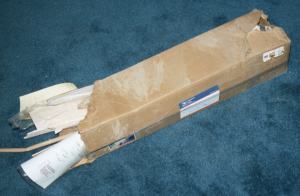 Forward:
Forward:
My NAR section will be hosting a 1/2A helicopter duration event this Fall and the only helicopter recovery rockets I've ever built were the massive fins with flaps type from Estes and Apogee. These are OK, but they're nowhere in the league of competition models. My plan was to purchase a couple of kits, assemble, and fly them and figure out the subtleties of this type of rocket. I was also spurred on by the creations of one of my fellow club members, Bob W., who has a model that seems to simply hang in the air. So I sent some money to QCR for two helicopter kits (and a glider kit for another event as well.) Unfortunately, the postal delivery service seems unable to figure out how to deliver mail to my front door, but instead chooses to deliver my mail to other houses and leaves them amid the known package chewing pooches that dwell there. They also have taken to leaving them laying on the road within a rock throw of the same dogs. This happened to the package of models from QCR.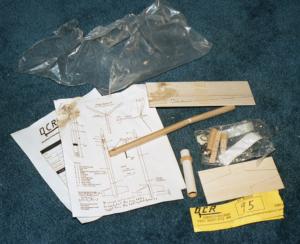 The box was a big one, easily accommodating the three kits with lots of foam peanuts, but no box is a good match for three sharp-toothed mutts. The rotors of one of the kits was chewed badly, and all of the body tubes, and the boom for the glider were also trashed. The kits do not have a set of templates for the parts, but instead the design is drawn out right on the balsa so simply substituting a slab for the chewed components is not possible for some items. For this kit, most of the parts were usable, but since I was ordering replacement parts anyway I requested a body tube for this kit, too. The small baggies of hinge parts came through OK. I shot off an e-mail to QCR requesting replacement parts. I also made some noise at the local post office about the ineptitude of the mail delivery service. Replacement parts arrived about a week later.
The box was a big one, easily accommodating the three kits with lots of foam peanuts, but no box is a good match for three sharp-toothed mutts. The rotors of one of the kits was chewed badly, and all of the body tubes, and the boom for the glider were also trashed. The kits do not have a set of templates for the parts, but instead the design is drawn out right on the balsa so simply substituting a slab for the chewed components is not possible for some items. For this kit, most of the parts were usable, but since I was ordering replacement parts anyway I requested a body tube for this kit, too. The small baggies of hinge parts came through OK. I shot off an e-mail to QCR requesting replacement parts. I also made some noise at the local post office about the ineptitude of the mail delivery service. Replacement parts arrived about a week later.
(When taking photos, I inadvertently got a part of kit #99 in with the #95 kit - the small tube and ring shown belong in that other kit.)
Construction:
The kit comes with a three-page set of instructions and two pages of plan drawings. The instructions are clear if brief. I was able to make out all that I needed despite the damaged plans.
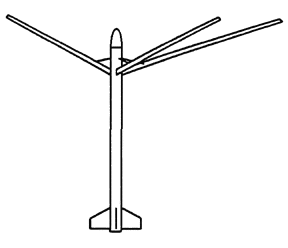 Construction starts with the blades. These are cut from slabs of 1/16 stock balsa. The quality of the balsa is good; nice and light competition stock with the grain running the length of the blades. I believe this is B grain. The kit comes with one of the blades marked up with blue ballpoint pen and it is used as a pattern to create two more from the sheet stock. The top of each is scored at an angle from corner to corner, and then they are cracked along the score to produce the basic airfoil shape. The blades are then glued to fix this shape, the gap is filled, and the airfoil is fine-tuned with sandpaper. I had a little trouble cutting the angles; this is a rookie thing to do, but I cut one with the angle opposite the other two. Oops, so I substituted a slab of long grain competition stock and cut another. There was a good bit of left over balsa, and I cut three 1/16 x 1/16 inch sticks and used those to facilitate cracking the blades along the cut to get the correct height and angle. Thin CA was used to set the angle, the gap filled with Elmer's Fill 'n' Finish and the whole lot sanded carefully to the shape shown on the plans. The Fill 'n' Finish was then soaked with CA to make sure that it stayed put. They are fairly light, and all three are about 4 grams together. The blades were then filled with three coats of Aerogloss sanding sealer. A hook was then glued to each blade for the rubber band.
Construction starts with the blades. These are cut from slabs of 1/16 stock balsa. The quality of the balsa is good; nice and light competition stock with the grain running the length of the blades. I believe this is B grain. The kit comes with one of the blades marked up with blue ballpoint pen and it is used as a pattern to create two more from the sheet stock. The top of each is scored at an angle from corner to corner, and then they are cracked along the score to produce the basic airfoil shape. The blades are then glued to fix this shape, the gap is filled, and the airfoil is fine-tuned with sandpaper. I had a little trouble cutting the angles; this is a rookie thing to do, but I cut one with the angle opposite the other two. Oops, so I substituted a slab of long grain competition stock and cut another. There was a good bit of left over balsa, and I cut three 1/16 x 1/16 inch sticks and used those to facilitate cracking the blades along the cut to get the correct height and angle. Thin CA was used to set the angle, the gap filled with Elmer's Fill 'n' Finish and the whole lot sanded carefully to the shape shown on the plans. The Fill 'n' Finish was then soaked with CA to make sure that it stayed put. They are fairly light, and all three are about 4 grams together. The blades were then filled with three coats of Aerogloss sanding sealer. A hook was then glued to each blade for the rubber band.
The body tube is pre-cut to length and pre-marked for fins and lugs, with the ejection escape holes punched neatly at the top. It also has marks for rotor hinge location. A small hole was made over each hinge location, and the pre-bent rubber band hooks were glued into them. The hooks are glued inside and out with thick CA. The inside of the rocket was coated with 30 minute epoxy all around the holes, hooks, and as far down as I can reach, and the nose cone (balsa) is placed into the top while the epoxy was still "wet."
A small hole is drilled into each side of the rocket just above the motor. When making the rocket ready for flight, a thread is run through these holes and looped around the blades to hold them for the boost. At ejection, the charge burns the thread thereby releasing the rotors.
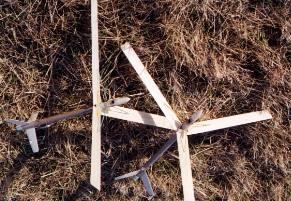 The kit came with an extra set of hinges and a small instruction sheet describing an alternative method of hinging the blades. The standard set of hinges are the conventional metal pin type. The second set of hinges are the new CA type, these are a thin sheet of very flexible plastic sandwiched between two fuzzy layers of material. I chose the conventional method for this rocket. The hinges are glued to the rocket at the marks on the tube below the holes and the hooks. The hinges are made such that one of the halves has pivot points on the outside, and one has its pivot point on the inside. The inside one, of course, is fixed to the tube to reduce friction on the hinge (or avoid gluing the pivot to the tube.) While this isn't mentioned in the plans it does seem obvious. The hinges are then wrapped with thread fixing them solidly to the airframe. I had some trouble with this - the hinges are huge and hang 'way over the sides of the tubes. After a couple shots at it I decided that maybe the hinge could be trimmed. I tried that with the diagonal cutters, and it was better but still not right. So I trimmed them again, but this time trimming to the width of the pivot - had to peal them off and reglue them. That worked, and the wrapping went a whole lot better. This was then painted with very thin CA, being careful to keep the CA out of the pivots.
The kit came with an extra set of hinges and a small instruction sheet describing an alternative method of hinging the blades. The standard set of hinges are the conventional metal pin type. The second set of hinges are the new CA type, these are a thin sheet of very flexible plastic sandwiched between two fuzzy layers of material. I chose the conventional method for this rocket. The hinges are glued to the rocket at the marks on the tube below the holes and the hooks. The hinges are made such that one of the halves has pivot points on the outside, and one has its pivot point on the inside. The inside one, of course, is fixed to the tube to reduce friction on the hinge (or avoid gluing the pivot to the tube.) While this isn't mentioned in the plans it does seem obvious. The hinges are then wrapped with thread fixing them solidly to the airframe. I had some trouble with this - the hinges are huge and hang 'way over the sides of the tubes. After a couple shots at it I decided that maybe the hinge could be trimmed. I tried that with the diagonal cutters, and it was better but still not right. So I trimmed them again, but this time trimming to the width of the pivot - had to peal them off and reglue them. That worked, and the wrapping went a whole lot better. This was then painted with very thin CA, being careful to keep the CA out of the pivots.
The fins, like the rotors, are marked with blue ballpoint on a slab of balsa. These were cut out with a straight edge and an X-acto knife. They were sanded to a thin, tapering airfoil (this is a competition model). An alternative fin shape is shown on the plans. The root edge of the fins was rubbed with yellow glue and allowed to dry. Another thin layer of yellow glue was applied to each of the fins and they were carefully placed on the airframe along the pre-drawn lines. The base edge of the fin is up from the bottom about a 5mm to allow a piece of tape to be wrapped around the motor and rocket base for retention. Fillets were added to the roots, and they were sealed like the rotor blades.
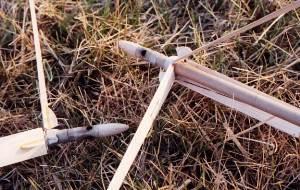 I would suggest finishing the rocket at this point if a finish is planned. Since this is a competition ship no finish is preferred to save weight. Magic markers could be employed to create a colorful rocket without adding much weight. I would suggest coloring the blade bottoms black or navy to improve visibility - speaking from R/C experience this really helps to keep the craft in sight.
I would suggest finishing the rocket at this point if a finish is planned. Since this is a competition ship no finish is preferred to save weight. Magic markers could be employed to create a colorful rocket without adding much weight. I would suggest coloring the blade bottoms black or navy to improve visibility - speaking from R/C experience this really helps to keep the craft in sight.
The blades are tack glued to the other leaf of the hinge at this point. I used slow CA and was careful to keep the CA out of the hinge line. I had applied a touch of oil to the hinge points earlier as insurance and to smooth up the operation. Each blade's position is checked against the rocket and against the other blades. They are then glued tightly, and a stop is added to the top of each one. The stop is adjusted to set the angle of the blades when open. The stops were simple rectangular 1/16 balsa blocks. I thought they were aesthetically unpleasing and cut them with a round top.
All up, it weighs 15grams unfinished.
Since the kit provided an extra set of hinges, and since I already have a mis-cut extra blade I decided to throw in a little more balsa and some BT-5 and make a second bird. This one uses the alternative hinge method. I also made a couple of changes to the fins - the original design requires a stand, and by putting a rake on these it will stand up on its own. Also, the instructions that came with the alternative hinges suggest that tape should be used for reinforcing the hinges but doesn't say what type of tape. I used the thread wrapping method instead. All up weight of the second model is 16 grams.
Rating: 4 out of 5 this isn't nearly as challenging to build as I thought it would be. One must pay particular attention to the plans and the blade details in order to get them right. The instruction sheet is little more than a check list to order the steps. This isn't bad if you have some experience building model rockets and airplanes, but a novice would be lost. Not the prettiest or smoothest finish I've seen! What we do for competition.
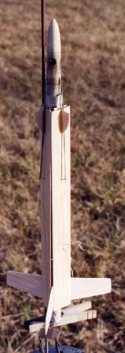 Flying:
Flying:
I had a couple of problems with making ready for the first flight. The rubber bands are stretched very far and pulled the top hooks loose from the glue - they held because they pass through the tube and are glued inside as well. Initially I thought that the blade hooks were located incorrectly, but I verified their location on the plans as correct. So I cured the trouble by adding a wrap of thread around them. I also had a lot of trouble threading the elastic thread through the small hole at the low end of the body. I was eventually able to fish it through using the wire end of an igniter to help guide it. A small tool was later made from .025 music wire to help with this task. One end is bent right over, the other end has some thread CA'ed to it to prevent it needling my fingers. For storage, this tool is slipped into the spool of elastic thread. The kit comes with a length of elastic, but only enough for one or two flights. I found a spool of the stuff at the local Hobby Lobby for a tad more than a buck.
I had a little bit of trouble finding motors for the first flight. I wasn't keen to use a full A and the local hobby supplier that I do most of my business with doesn't carry 1/2A3-2Ts. I was eventually able to locate some locally, though. I also have some Apogee motors left that I'm planning to give a whirl during my testing and experimenting (they can't be used in competition currently).
Since there are two models, my intention was to fly them both using the same motors and compare the times. Unfortunately, due to some problems with binding on the launch rod, distractions taking photos in flight, and my fat fingers on the watch buttons my data isn't very good. Here it is anyway.
March 17, 2002 Partly cloudy, light and variable winds with periods of dead calm.
| Flight # | Pinned-hinge | Flexi-hinge |
| 1 | forgot to time | 8 Seconds (bound on rod) |
| 2 | 31.03 Seconds | 22.72 Seconds |
| 3 | 25? Seconds (fat finger) | 23.47 Seconds |
| 4 | forgot to stop watch | 10.02 Seconds (bound on rod) |
All eight motors are Estes 1/2A3-2T of lot A122799. No misfires.
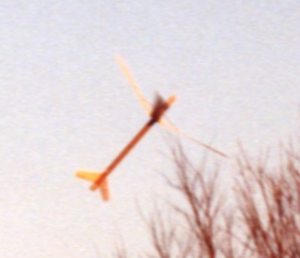 Both models had a really bad pendulum effect working starting a few moments after deployment. The times would probably be a whole lot better were it not for this effect; so I took some time that evening to see if I could figure out what might cause this. On the pinned-hinge model I found that one of the blades was higher at the tip than the others. On the flexi-hinge none of the three blades was the same. The blade stops were adjusted. This helped some on the pinned model, but actually made the flexi model much worse. At times it gets nearly horizontal.
Both models had a really bad pendulum effect working starting a few moments after deployment. The times would probably be a whole lot better were it not for this effect; so I took some time that evening to see if I could figure out what might cause this. On the pinned-hinge model I found that one of the blades was higher at the tip than the others. On the flexi-hinge none of the three blades was the same. The blade stops were adjusted. This helped some on the pinned model, but actually made the flexi model much worse. At times it gets nearly horizontal.
The flexi-hinge model had a lot of trouble with binding on the rod; I think this is because the rod is allowed to simply pass along the side of the model under one of the rotors. My attempt to fix this is to add a 1/4-inch long lug just above and offset from one of the fins. That worked, and on the second set of test flights it didn't bind at all.
Something else I noticed with the flexi-hinge model is that the fins caused it to spin on the way up. This would be a lot better if the spin imparted by the fins was in the same direction as the descent spin. I tried testing this theory by adjusting the fins on the second model to set the rocket spinning in the correct direction, but found that hardly works at all, when the blades deploy it stops spinning anyway. Good idea but isn't practical in the real world.
Finally, I forgot to put a small piece of tape or something on the underside of the rotors where the elastic hole is resulting in the ejection charge actually burning clean through one of the rotors. This is my oversight, the builder is instructed to do this. I've corrected this on both models and had no problems with it on the second set of tests.
Second group of flights, March 20, 2002. 50 degrees F, nearly calm winds, and very sunny.
| Flight # | Pinned-hinge | Flexi-hinge |
| 1 | 38.18 Seconds | 26.12 Seconds |
| 2 | 29.31 Seconds | 27.37 Seconds |
| 3 | 39.90 Seconds | 28.32 Seconds |
| 4 | 27.84 Seconds | 23.06 Seconds |
All eight motors are Estes 1/2A3-2T of lots A050301 and A122799. Two of each lot were flown in each model. No misfires. Both models are unfinished (still). On the 39.9 second flight there were vultures riding thermals overhead during the descent.
As you can see, we're getting close to competition level flights with the pinned hinge model. There were zero deployment problems in sixteen flights.
Rating: 5 of 5 - need some work to get better hang times. Lots of fun to fly but fairly labor intensive to prepare before each flight.
Specs:
- Body Length: 12 3/4 inches
- Body Diameter: 9/16 inches (13mm)
- Blade Length: 9 inches
- Blade Width: 1 3/16 inches
- Weight: 15g
- Motors: Estes 1/2A3-2T; A3-4T; A10-3T; Apogee (with adapter) 1/2A2-2; A2-3
Cheers & Jeers:
This is a pretty competitive kit. Just twirling it and tossing it gently produces a pretty impressive hang time. While not a kit for a beginner, it is a good learning tool for semi-advanced construction and recovery methods and has definitely started the wheels turning for a design of my own. The pre-marked body tube and pre-bent rubber band hooks are a joy.
The plans are complete and clear, but the instructions are very brief. A little more written detail, particularly regarding blade construction would be quite helpful.
 |
 |
Flights
 |
 |